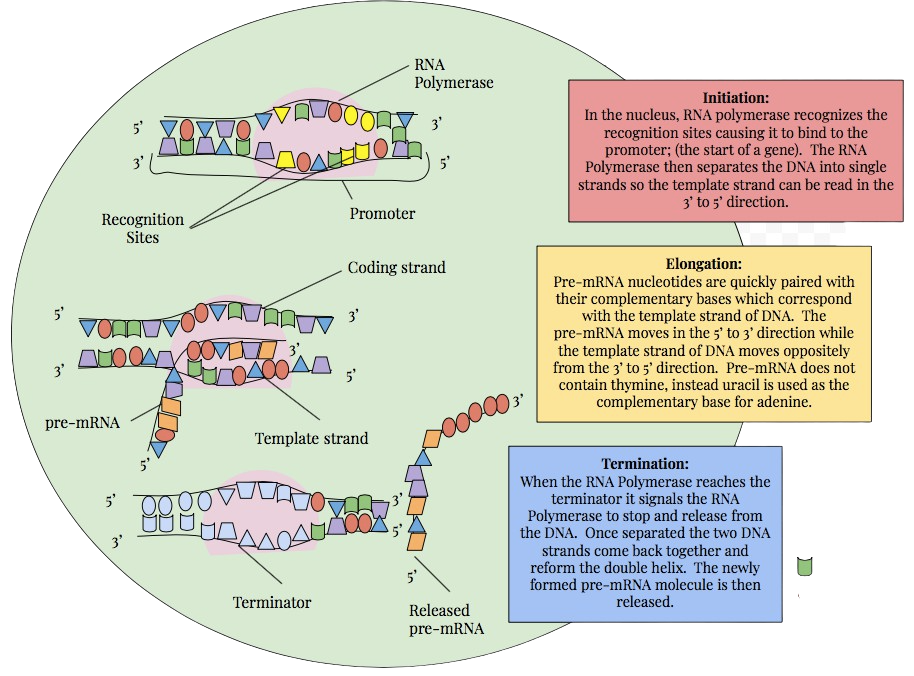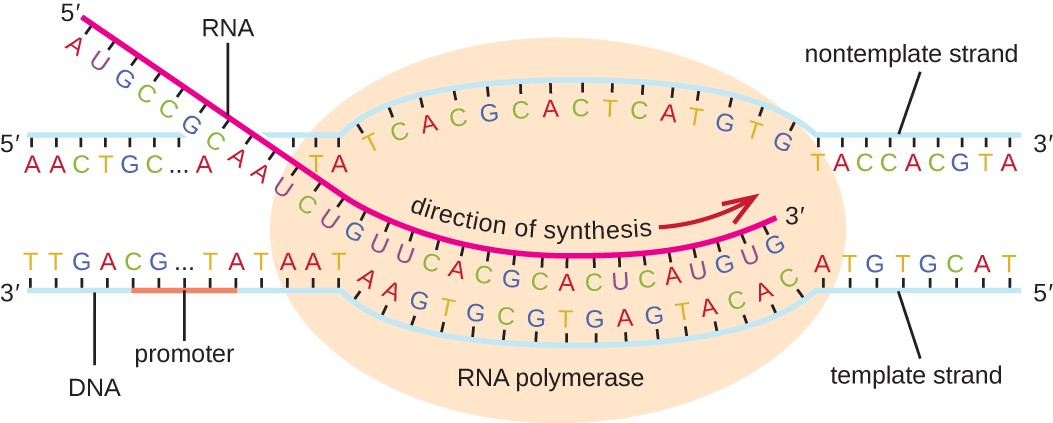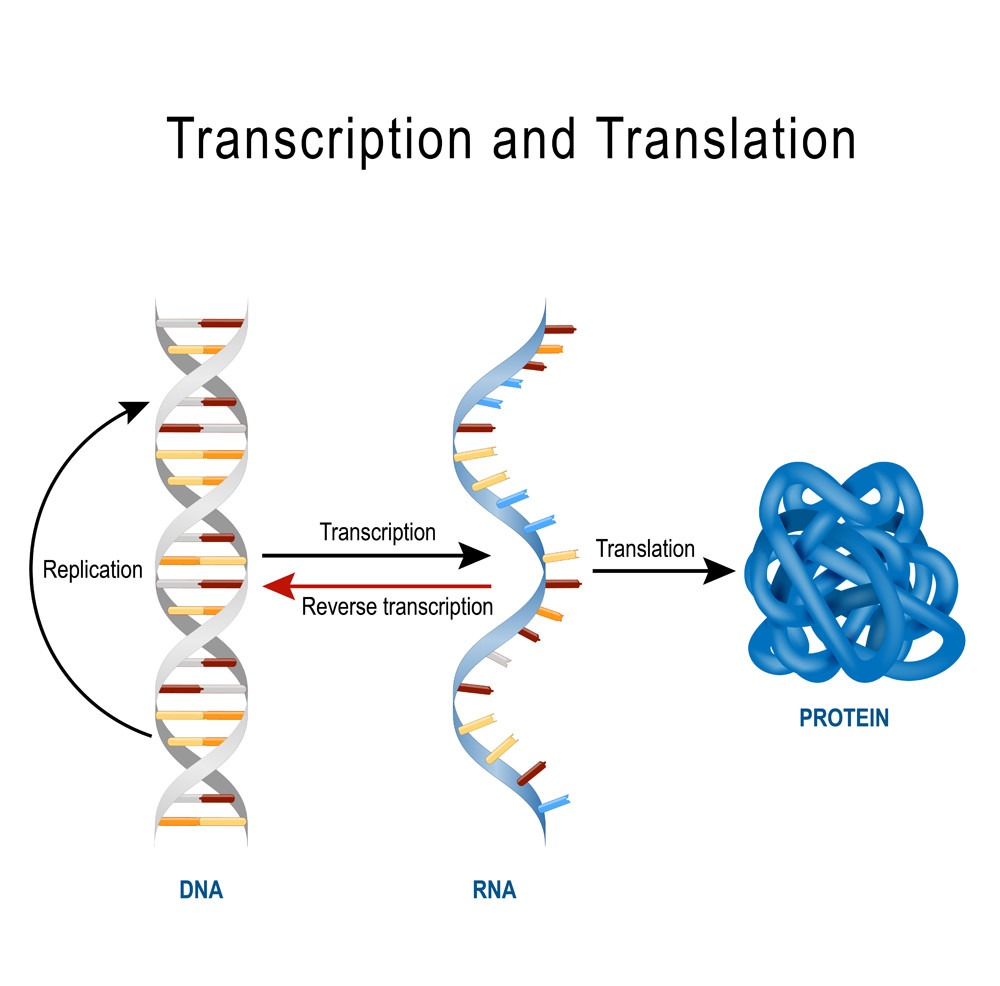RNA Transcription Study Guide
Interactive Simulation
Youtube Guide
Introduction
What’s RNA polymerase? Since you asked, RNA polymerase is a special enzyme that’s responsible for translating DNA into RNA in a process called transcription. Well, what’s transcription? Is it important? Yes, it is important! But why is it important? How does it work? Read on to find out!
Lesson Objectives
- Understand the process of RNA transcription in biology
- Understand the post-transcriptional modification of mRNA
- Understand the differences between transcription and translation
Transcription
Transcription is a key player in the creation of proteins, macromolecules that perform a variety of functions in a cell to keep it running. Some proteins serve as antibodies and enzymes, some provide structural support, and others are used to transport and store atoms or other small molecules around a cell. They’re involved in virtually every single cell function that exists (which is super cool, but we’re here to talk about transcription today, so let’s get back to that).
Transcription is basically the first step to create a protein. During the process, RNA polymerase uses DNA as a template to translate DNA into a format that the rest of the cell can read through base pairing. The format in question is that of messenger RNA (mRNA for short). The mRNA is transported to the cytoplasm, where it’s picked up by a ribosome, which translates it again, and blah blah blah a bunch of other steps, and we finally end up with our protein (we don’t think the part in the middle is actually blah, but it’s not important for us to know right now). Now that we’ve got the gist, let’s move on to learn about the actual process of transcription.
Stages of Transcription
Transcription occurs in three stages: Initiation, Elongation, and Termination. Let’s jump right in with initiation.

Initiation
Initiation is the first step of transcription. It starts when RNA polymerase binds to a region on the DNA strand called a Promoter (which basically tells the RNA polymerase where to start transcribing). When the RNA polymerase attaches to the promoter, it unwinds a portion of the double-helix to create a sort of bubble between its strands as can be seen in the image above.
Elongation
After RNA polymerase binds to the promoter, Elongation, the second stage of transcription, can begin. During elongation, RNA polymerase attaches to one of the strands of the DNA (known as the Template Strand) and moves along it in the 3’ to 5’ direction, adding nucleotides along the way.

RNA nucleotides are mostly the same as the DNA nucleotides, but they have one major difference. Adenine (A), thymine (T), cytosine (C), and guanine (G) are the four different DNA nucleotides. RNA nucleotides are the same, except instead of thymine, they have uracil (U). As always, nucleotide base pairs are complementary. C always pairs with G, and A always pairs with T, except in the case of RNA, where A matches with U instead.
As it moves along the template strand, RNA polymerase adds the appropriate complementary nucleotides in a sequence almost identical to the other strand of DNA (known as the Coding Strand). The only difference is that uracil is substituted for thymine, as you can see in the A-U pairing in the diagram below. As new nucleotides are added, the RNA strand becomes longer, which is where this particular stage of transcription gets its name (long-er, e-long-ation, get it?).
Termination
Elongation continues until the RNA polymerase encounters a “stop sequence” called a Terminator on the DNA strand. A terminator is a chunk of nucleotides in a specific order that indicates the replication process is over. Termination begins once the terminator has been reached, and as quickly as it starts, it ends. Because once the new RNA strand is complete and RNA polymerase detaches from the DNA, the process of transcription is over.
Pre-translational mRNA Processing
Remember before when we were talking about mRNA? Well, that brand new strand of RNA that we just spent all this time making isn’t actually messenger RNA yet. We call it Pre-mRNA, and during Pre-mRNA Processing, we apply the finishing touches by adding a 5’ cap and a poly-A tail and removing “junk” sequences through a process called splicing.

5’ Cap and Poly-A Tail
Think of our strand of RNA as a shoelace that’s fraying at the ends. If we leave the ends loose, our entire shoelace may end up unraveling, which is why we seal the tip with an aglet (a fun new little vocab word for you). The 5’ cap that we add to the RNA strand works in a similar way.
The 5’ Cap is made of methylated guanine and is attached to the first nucleotide of the strand at the 5’ end to protect it from being broken down. It’s also the point where ribosomes in the cytoplasm can attach to it to begin protein synthesis. The Poly-A Tail is made of hundreds of adenine nucleotides and is attached to the 3’ end of the strand to stabilize the RNA molecule and help it move from the nucleus to the cytoplasm.
Splicing
Now that we’ve tied up all of our loose ends (hah), the final RNA processing event, RNA splicing, can begin. In our strand of RNA, we have a bunch of good parts that we call Exons and a few bad ones that we call Introns. Introns aren’t inherently bad, they’re just sort of useless, and they prevent the mRNA from coding a new protein with all of the good parts of the sequence. Introns are removed with a protein-RNA complex called a spliceosome. Once they’re gone, the spliceosome seals together the rest of the exons to create the final, complete strand of mRNA that is then shipped out of the nucleus to the cytoplasm.
Translation vs Transcription
In Transcription, RNA polymerase creates a strand of RNA by using DNA as a template. We’ve already gone through that process, so let’s skip ahead to when the finished strand is shipped out from the nucleus.
Translation begins when a ribosome in the cytoplasm attaches to the new mRNA strand. The small subunit of the ribosome translates the mRNA for the large subunit of the ribosome, which then creates a polypeptide chain (an incomplete protein) based on what it says.
Basically, transcription uses DNA to make mRNA in the nucleus, and translation uses mRNA to synthesize proteins in the cytoplasm.

FAQs
1. What is transcription?
The process through which DNA is copied to RNA is called transcription.
2. What are the 3 stages of transcription?
Initiation, elongation, and termination are the three stages of transcription.
3. What is the difference between transcription and translation?
During transcription, DNA polymerase makes mRNA from a DNA template in the nucleus, while in translation, ribosomes synthesize proteins from the mRNA instructions in the cytoplasm.
4. What is an intron?
An intron is a “junk” sequence in an RNA strand that is removed during the splicing stage of pre-translational mRNA processing.
5. What occurs during initiation?
During initiation, RNA polymerase binds to the promoter on the DNA strand.
6. How does DNA polymerase know when to stop transcribing RNA from DNA?
DNA polymerase stops transcription when it meets a specific sequence of nucleotides on the DNA strand called a terminator.
7. Does DNA polymerase add nucleotides to the template strand or the coding strand?
The template strand.
We hope you enjoyed studying this lesson and learned something cool about Transcription! Join our Discord community to get any questions you may have answered and to engage with other students just like you! Don’t forget to download our App and check out our awesome VR room for this guide – we promise, it makes studying much more fun 😎
Sources
-
“Transcription | Definition, Steps, & Biology | Britannica.” Encyclopædia Britannica, 2019, www.britannica.com/science/transcription-genetics. Accessed 15 Nov. 2021.
-
Khan Academy. “Stages of Transcription.” Khan Academy, 2018, www.khanacademy.org/science/biology/gene-expression-central-dogma/transcription-of-dna-into-rna/a/stages-of-transcription. Accessed 15 Nov. 2021.
-
Wikipedia Contributors. “Transcription (Biology).” Wikipedia, Wikimedia Foundation, 14 June 2019, en.wikipedia.org/wiki/Transcription_(biology). Accessed 15 Nov. 2021.
